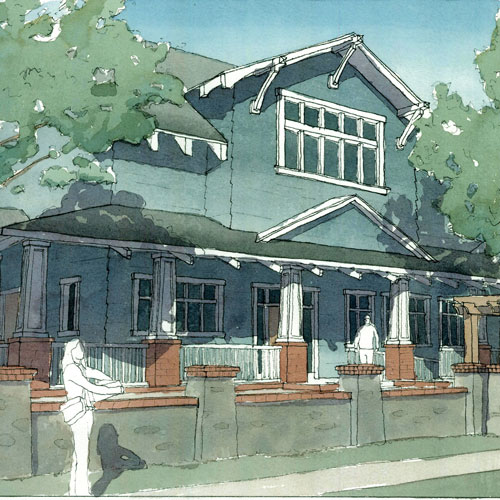
On Manhattan’s Upper East Side, blocks from the Metropolitan Museum of Art and the Guggenheim, a major renovation and expansion is taking place at the Nightingale-Bamford School.
Founded in 1920 by Frances Nicolau Nightingale and Maya Stevens Bamford, the independent K–12 all-girls private school is known for its rigorous liberal arts curriculum that sets students on a path toward elite colleges and distinguished careers. The institution enrolls 570 students from across the five boroughs and boasts an average class size of 12. Annual K–12 tuition is $44,400, and the school has a $73 million endowment. Teachers have been exhibited in US and European museums and been nominated for Pulitzer Prizes and National Book Awards.
Soon, a redesign by BRB Architects will incorporate two adjacent brownstones into the academic paradise. The historic structures, at 28 and 30 East 92nd Street, designed by Henry Hadenbergh—architect of the Dakota, the Plaza, and the Waldorf-Astoria—will be connected to the existing main school building at 20 East 92nd Street, and the unified layout of the school’s new and old properties will allow students in different grades to share common spaces and regularly interact.
“We are a school that believes in being one community,” says Susie Heller, Nightingale-Bamford’s director of facilities and a school alumna. “We had the rare opportunity to purchase two adjacent brownstones. The Board of Trustees felt this was an opportunity that we couldn’t pass up. The new space offered new possibilities for collaboration among adults and students as well as flexibility in scheduling.”
Nightingale-Bamford has been working closely with BRB, McGowan Builders, and New York City’s Landmarks Preservation Commission to ensure that its expansion will preserve the brownstones’ century-old brick façades as well as a distinctive rear extension with a bay window. When complete in April 2016, though, the insides of the buildings will look completely different and will add 25,000 square feet of space—including science labs, a robotics studio, a greenhouse, a blackbox theater / multipurpose space, specialized music practice rooms, a new athletic training and fitness room, and a digital media lab—to a school spread across nine floors. Additional modifications to the school’s existing facilities will lead to larger art studios, a newly imagined Middle and Upper School Library, an expanded Lower School Library, a redesigned student center, one new Lower School science lab, a public speaking theater, and an Upper School Commons.
It’s a massive undertaking. And, perhaps most impressively, it will all be done while keeping students and staff in one building and minimizing disruption to school operations and a busy Upper East Side neighborhood.
Renovating from the Bottom Up
Construction on the two adjacent brownstones began in summer 2014, and one of the first steps was to give them what Ron Agababian, director of business development at McGowan Builders, refers to as a “façadectomy.” After shoring up the buildings with steel girders, McGowan demolished their interiors and six of their eight outer walls, leaving behind just the red brick fronts, almost like a Hollywood set. The builders then went down, excavating the rocky soil underneath the structures and pouring a new foundation.

Prior to the turn of the century, many New York City brownstones were built on sledge rubble only five or six feet beneath ground level—fine for lightweight wooden skeletons, but unfit for the needs of modern commercial construction. Dismantling the structures and breaking through a subterranean rock ledge to open a new lower level required extraordinary care and ingenuity. “You don’t go in there with a wrecking ball,” Agababian says. “It’s too risky. It’s like an erector set: you dismantle it piece by piece. It’s done very carefully.”
Another early step was to reconfigure Nightingale-Bamford’s front lobby, accessible from East 92nd Street near Fifth Avenue. The building’s renovated public entrance now opens to an elevator bay, a gallery of student work, display cases with ceramics, and a recycling center. A flight of stairs descends from the lobby to a landing in the basement, where students can enter the school’s auditorium and where they’ll eventually be able to access the blackbox theater / multipurpose space.
The refurbished student center, a major achievement, was finished in summer 2014. Even prior to renovation, the second-floor lunchroom was bright and inviting, with natural light streaming in through a skylight that made good use of the building’s recessed design. By bumping out the south wall more than a foot, though, and adding an east-facing window, the renovation has succeeded in bringing even more light into the space. At a long U-shaped salad bar, students and teachers can find healthy lunch options, and new tile flooring, lighting updates, and ergonomic Humanscale chairs complete the relaxed, café-style space, used not only for lunch but also as a meeting area.
Additionally, many existing classrooms have been gutted, moved to a different portion of a floor, or moved to another floor entirely, and some are being redesigned for the brownstone addition. Library books have been packed up and moved to classrooms. First-floor administrative offices were moved to a temporary location within the existing building after the summer 2014 renovation, and faculty will move to temporary rooms within the building after the summer 2015 renovation. It’s like a giant game of Tetris.
In all phases of the renovation, though, coordination between Nightingale staff, BRB, McGowan Builders, and movers from Clancy Cullen has helped and is helping minimize disruption of the school day and the school calendar. Heller has become something of an air traffic controller, asking teachers to pack up books and supplies early, color coding and numbering furniture that will be stored off-site, and ensuring security and announcement systems, phone lines, servers, and fire alarms are appropriately updated and wired in the new brownstone expansion. “When we renovated in 1989, we were in 17 different locations,” Heller says. “In this renovation, we have not left this building.”
The “One Schoolhouse” Model
Renovations to Nightingale-Bamford’s lower level and first floor were completed in summer 2014. A large first-floor music room now allows students more freedom of movement, and it sits adjacent to a companion room exclusively for stringed instruments. The admissions office is bigger, and a new first-floor classroom and business office has been created. Additionally, in keeping with the Landmarks Preservation Commission’s mandate to preserve the one brownstone’s bay window, the school’s Head’s Office will move to the first floor of that home’s boot-shaped southern wing and overlook a garden south of the building.
As of press time, renovations to floors two through six were scheduled to take place over eight weeks in summer 2015. The remodeled third floor, where many Upper School classrooms are concentrated, will include a square seminar room, an alumni conference room, a jury room for public speaking, and student homerooms with space for 50 students and retractable partitions that can be used to subdivide each room into smaller portions. Many of the rooms will resemble design studios, with bright, primary-colored furnishings and glass-paneled walls that will let light into the hallway.
On the fifth floor, the open design of the Lower, Middle, and Upper School science labs will give teachers a conspicuous vantage for lab instruction, Epson Bright Links digital projectors will allow for interactive lessons via fingertip or a stylus pen, and rolling, swiveling Node chairs by Steelcase will allow students to transition between different activities while maintaining an open sight line with teachers, students, and projector images.

All the renovations reflect Nightingale’s “one schoolhouse model,” in which shared, flexible spaces can be used by teachers and students for various purposes according to a rotating block schedule. “Nightingale looks at every space for every girl at all times,” Heller says. “Sharing spaces among divisions helps with relationship building among our students as they fulfill community-service requirements and work together; it’s all part of living and helping one another as a community.”
The Brownstone Expansion
At least in the near future, Nightingale is not planning an enrollment increase. A small student body means students feel valued as individuals, receive highly individualized instruction, and develop close bonds with their teachers and with each other. So then why the push for expansion?
The main reason for it, according to board president and architect Rebecca Rasmussen, is to increase the school’s number and diversity of course offerings and to provide different types of spaces for teaching. “If, in the Upper School, four or five girls are interested in advanced math or genetics, we’ll be able to layer in these classes,” Rasmussen says. “We’ll have the physical footprint to say, ‘OK, there are a few of you who are interested in this class; we can offer it because we have the space and a faculty member willing to teach it.’”
At the same time, increased server capacity and videoconferencing technology will increase opportunities for distance learning. Through collaborations with organizations such as Interschool, a consortium of independent schools in NYC, small groups of students from Nightingale-Bamford and several other schools will be able to hold real-time, virtual class sessions. “Nightingale is a fairly small school,” Rasmussen says. “We love that. What is nice is all students are known and all teachers have good connections with the girls. With a small population, though, it starts limiting specialty classes students can take in school. If you can do things with technology to connect students to other schools and teachers, it opens up the world to these girls.”
Heller, who has been overseeing the expansion and renovations from the beginning, looks forward to seeing the newly reconfigured school in full use. “Everybody has been great,” she says. “There is a light at the end of the tunnel. What it will be at the end will be wonderful.”


